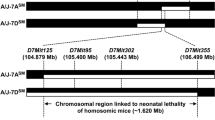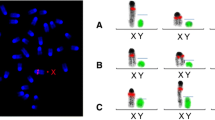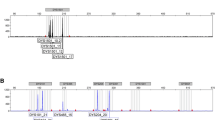Abstract
The dominant hemimelia(Dh) mutation causes various developmental abnormalities in mice. Most -Dh/+ males, crosses between DDD females and DH-Dh/+ males, have lethal abnormalities during the neonatal period. This is a consequence of synergism among three independent gene loci; that is, theDh allele on chromosome (Chr) 1, the DDD allele on an X Chr-linked locus, and a Y Chr-linked locus in some strains. With regard to the Y Chr derived fromMus musculus musculus (M. m. musculus), the Y Chrs of C57BL/6J and BALB/cA caused lethality, but the Y Chr of C3H/HeJ did not, suggesting that not allM. m. musculus Y Chrs are the same. In the present study, whether Y Chrs derived fromM. m. domesticus andM. m. castaneus could cause lethality was investigated. Among seven inbred strains, including AKR/J, DDD, RF/J, SJL/J, SWR/J, TIRANO/Ei, and CAST/Ei, Y Chrs of AKR/ J, DDD, SJL/J, SWR/J, and TIRANO/Ei caused lethality, but Y Chrs of RF/J and CAST/Ei did not. It was unlikely that the mitochondrial genome of the DDD strain contributed to the lethality. The X Chr-linked locus could not compensate for the role of the Y Chr-linked locus. These results suggest that not allM. m. domesticus Y Chrs are the same.
Similar content being viewed by others
References
Albrecht KH, Eicher EM (1997) DNA sequence analysis of Sry alleles (subgenus Mus) implicates misregulation as the cause of C57BL/6J-Y(POS) sex reversal and defines the SRY functional unit. Genetics 147, 1267–1277
Carlisle C, Winking H, Weichenhan D, Nagamine CM (1996) Absence of correlation betweenSry polymorphisms and XY sex reversal caused by theM. m. domesticus Y chromosome. Genomics 33, 32–45
Coward P, Nagai K, Chen D, Thomas HD, Nagamine CM, et al. (1994) Polymorphism of a CAG trinucleotide repeat within Sry correlates with B6.YDOM sex reversal. Nat Genet 6, 245–250
Eicher EM, Washburn LL, Whitney JB 3rd, Morrow KE (1982)Mus poschiavinus Y chromosome in the C57BL/6J murine genome causes sex reversal. Science 217, 535–537
Eicher EM, Washburn LL, Schork NJ, Lee BK, Shown EP, et al. (1996) Sex-determining genes on mouse autosomes identified by linkage analysis of C57BL/6J-YPOS sex reversal. Nat Genet 14, 206–209
Searle AG (1964) The genetics and morphology of two “luxoid” mutants in the house mouse. Genet Res 5, 171–197
Suto J, Imamura K (1996) Rectovesical fistula: a possible cause of postnatal lethality in F1 Dh/+ male mice between DDD female and DH(Dh/+) male. Exp Anim 45, 399–402
Suto J, Wakayama T, Imamura K, Goto S, Fukuta K (1996) High lethality of F,(Dh/+) male mice from the cross between DDD female and DH (Dh/+) male. Exp Anim 45, 99–101
Suto J, Yamanaka H, Sekikawa K (1999) Genetic analysis of neonatal death with growth retardation in F1 maleDh/+ mice. Mamm Genome 10, 777–783
Tucker PK, Lee BK, Lundrigan BL, Eicher EM (1992) Geographic origin of the Y chromosomes in “old” inbred strains of mice. Mamm Genome 3, 254–261
Author information
Authors and Affiliations
Rights and permissions
About this article
Cite this article
Suto, Ji., Sekikawa, K. Y-chromosomal factor is involved in neonatal lethality in (♀ DDD × ♂DH-Dh/+) F1-Dh/+ male mice. Mammalian Genome 13, 149–152 (2002). https://doi.org/10.1007/BF02684019
Received:
Accepted:
Issue Date:
DOI: https://doi.org/10.1007/BF02684019




